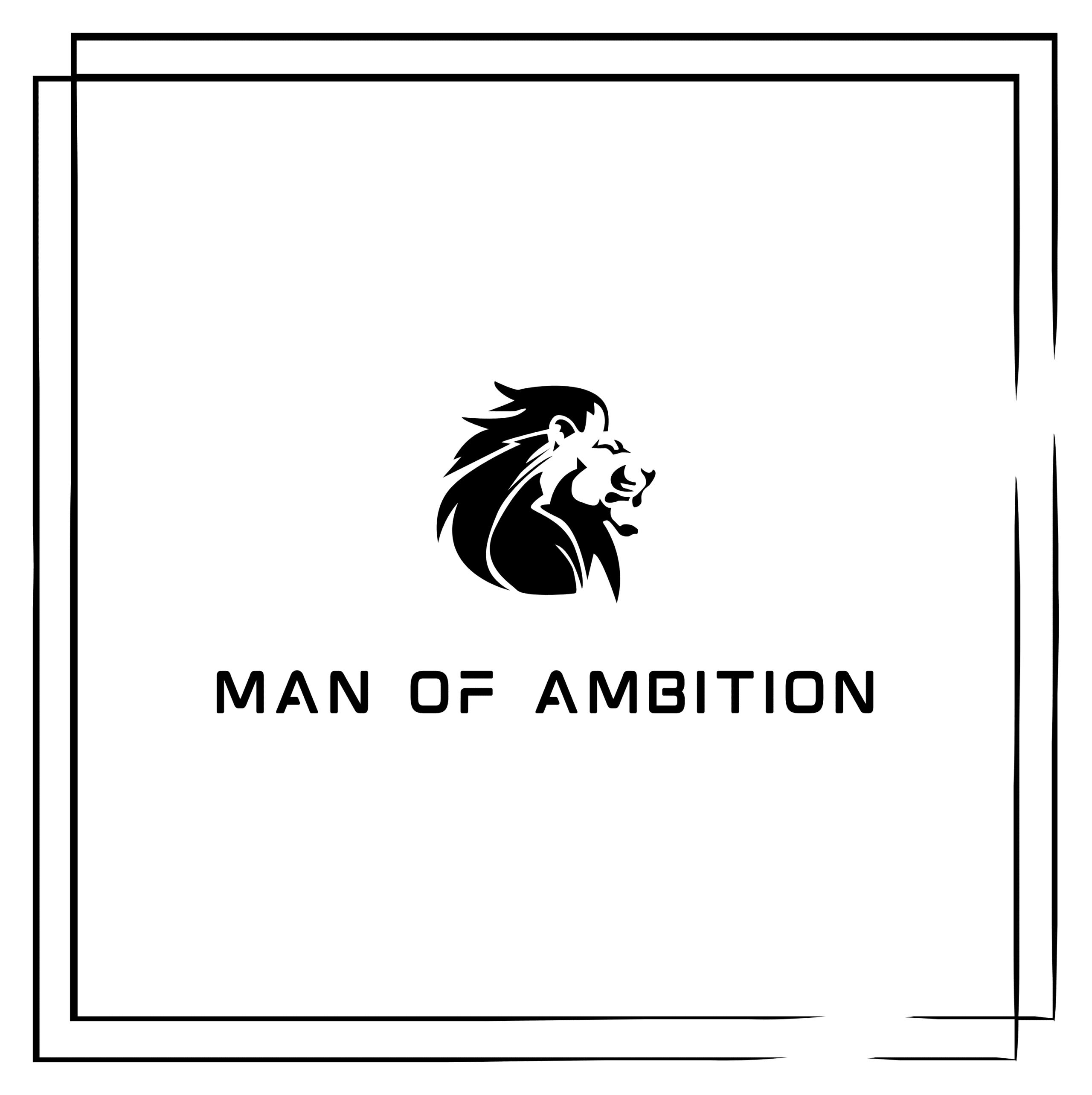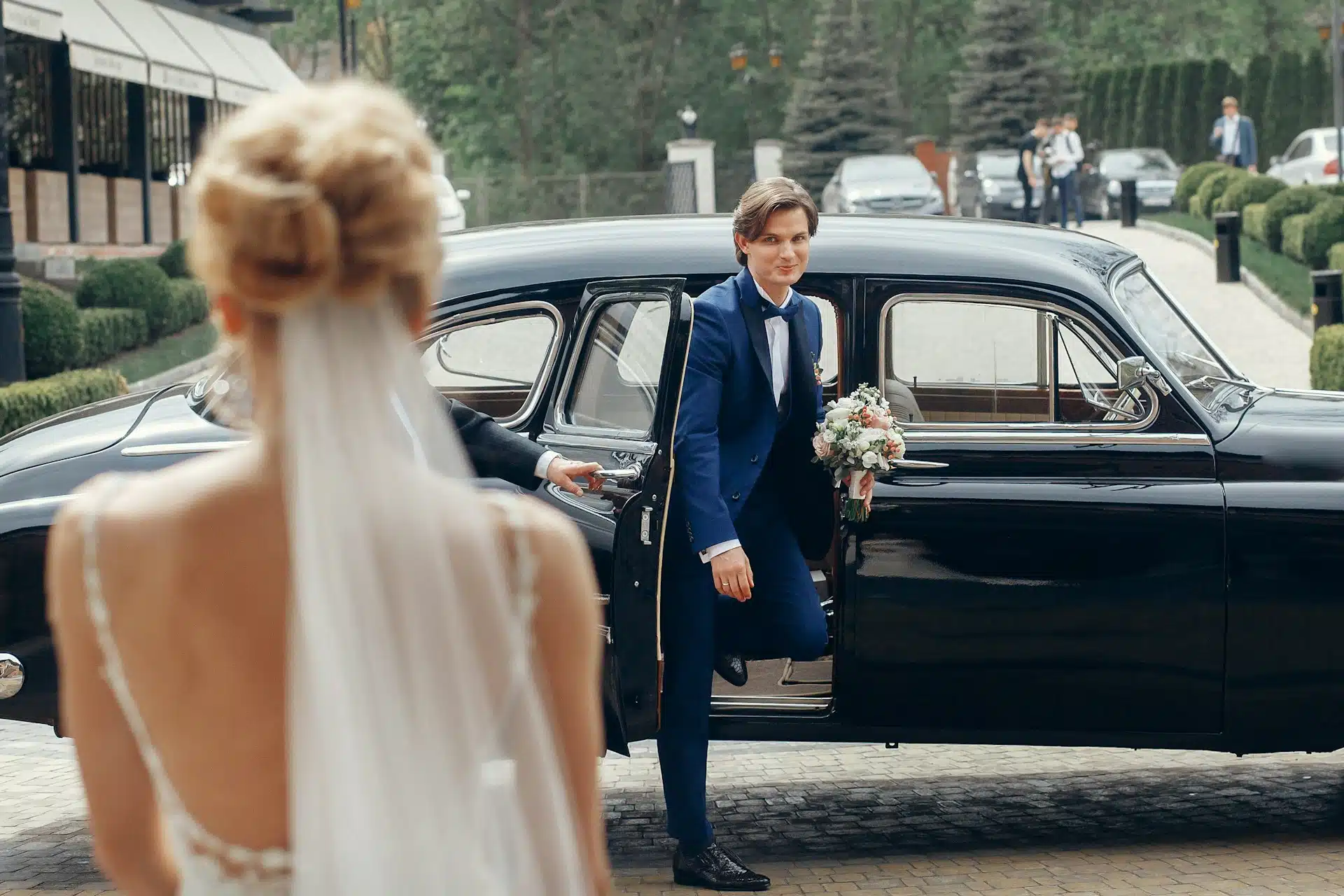Style is a language of its own—a powerful, unspoken expression of who you are. Each person has a distinct sense of fashion, a way of dressing that tells a story before they even say a word.
Dressing for a wedding allows you to embrace the beauty of style as a form of personal expression. Are you feeling refined and classic, perhaps leaning toward a tailored suit with a sleek tie?
Or do you want to bring a modern twist with bold colors, unexpected accessories, or unique textures that showcase your individuality? The options are endless, and each choice has the power to communicate who you are and how you feel in the moment.
Ahead, we’ll explore how you can find the perfect outfit that not only fits the occasion but also embodies your personality and sense of style.
Understanding Wedding Dress Codes
Grasping the nuances of wedding dress codes is fundamental for any man looking to navigate the sartorial expectations of such a special occasion. From the formality of a black-tie event to the relaxed vibe of a casual gathering, each dress code dictates a specific standard of dress that ensures guests are uniformly well-presented and in harmony with the wedding’s theme.
Deciphering Black-Tie and White-Tie Invitations
Upon receiving a black-tie or white-tie wedding invitation, men should prepare to embrace the highest standards of formal wear.
For black-tie attire, the quintessential choice is to wear a tuxedo, complete with a black bow tie, cummerbund, and patent leather shoes. This attire is sophisticated yet not overly flashy, perfect for evenings of refined celebration.
White-tie invitations, on the other hand, call for even more formality. Men must don a tailcoat, white vest, white bow tie, and polished formal shoes. Adhering to these guidelines is crucial, as they epitomize the pinnacle of men’s formal wear, reserved for the most ceremonial of occasions.
Navigating Semi-Formal and Cocktail Attire
Semi-formal and cocktail attire for men typically involves a blend of sophistication and personal style within formal dress codes. A dark suit, preferably in charcoal grey or navy, paired with a crisp white shirt, allows for flexibility.
Adding a cocktail dress shirt with a subtle pattern and leather shoes completes the look, striking the perfect balance for these moderately formal events.
Choosing the Right Look for Casual and Outdoor Weddings
Men should look to dress code guidelines for casual and outdoor weddings that allow for a more relaxed yet presentable appearance. A smart-casual approach could include wearing chinos or khaki pants paired with a linen shirt or a lightweight blazer. This attire is appropriate for a laid-back setting while maintaining a sense of occasion.
Creative Twists on Traditional Attire for Unique Weddings
Unique weddings offer the opportunity to experiment with traditional attire. Men can opt for a statement dinner jacket or incorporate patent leather shoes for a modern edge. These creative twists are ideal for making a personal style statement while resonating with the event’s distinctive character.
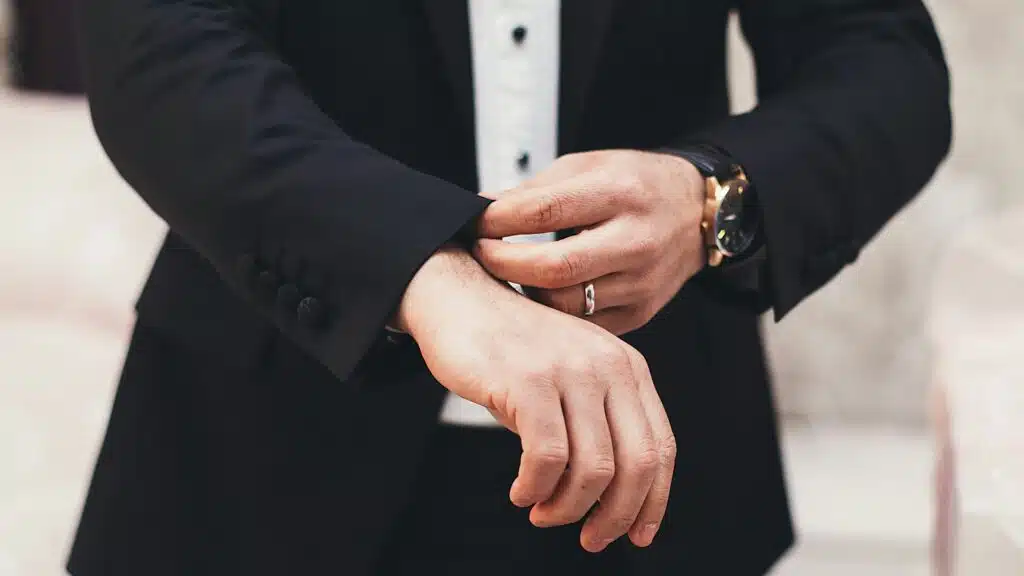
Essential Men’s Wedding Attire by Season
Seasonality plays a crucial role in selecting appropriate wedding attire. A dark-colored suit may be suitable for a fall or winter wedding, offering both warmth and elegance.
Spring Wedding: Fresh and Colorful Ensemble Choices
Spring weddings call for fresh and colorful attire choices. As nature awakens, men can embrace the season by incorporating pastel or vibrant hues into their suits or ties. Lightweight fabrics and a well-chosen pocket square can add a celebratory feel to the ensemble.
Accessorizing with a bright tie or a floral lapel pin can further enhance the springtime vibe, making for a stylish and season-appropriate outfit. The goal is to look sharp and festive, in tune with the joyous spring atmosphere.
Summer Celebrations: Staying Cool and Stylish
For summer weddings, the challenge is to stay cool while maintaining a touch of sophistication. Breathable fabrics like linen or cotton are ideal for men’s summer wedding attire, allowing for comfort in warmer weather. Lighter colors reflect the sun’s rays and contribute to a cooler feel.
Accessorizing with a patterned tie or a pocket square in a pop of color can elevate the look, ensuring that while the outfit is suitable for the heat, it does not sacrifice style. The key is to blend practicality with elegance, suitable for summer weddings’ relaxed yet celebratory nature.
Fall Festivities: Embracing Warm Tones and Textures
Fall weddings invite men to embrace warm tones and rich textures in their attire. Earthy colors like burnt orange, deep reds, and forest greens reflect the season’s palette. Fabrics such as tweed or wool add texture and warmth, making them suitable for cooler temperatures.
Including accessories like a patterned tie or a pop of color in the form of a pocket square can add visual interest to the outfit. These elements allow for personal expression within the bounds of the wedding’s style and the seasonal context.
Winter Weddings: Layering Elegantly for Men
Men’s winter wedding attire often involves layering to combat the cold while adhering to formal or black-tie dress codes. A well-tailored overcoat or a classic pea coat can provide warmth without compromising the formality of the occasion.
Rich, dark colors and luxurious fabrics like cashmere or velvet add to the seasonal appropriateness of the look. Underneath, a dark suit or tuxedo should be complemented with a scarf or gloves in coordinating colors.
These accessories provide comfort against the chill and contribute to the overall elegance of the winter wedding ensemble.
Selecting the Perfect Wedding Suit
Choosing the perfect wedding suit is a pivotal decision for any man. Whether it’s a beach wedding or a formal reception, the wedding outfit for men typically revolves around suits and tuxedos paired with a crisp white shirt. The focus should be finding a suit that fits impeccably, reflects personal style, and is appropriate for the wedding’s setting.
The Importance of Suit Fit and Tailoring
The fit of the suit jacket and trousers is paramount in creating a polished appearance. A well-tailored suit flatters the wearer’s body shape, allowing for ease of movement and a sharp silhouette. Investing in quality tailoring ensures that the suit looks custom-made and enhances the overall sophistication of the look.
How to Achieve the Ideal Suit Fit
To achieve the ideal suit fit, attention to detail is key. The suit jacket should lie flat against the chest, and the shoulders must be snug without pulling. Trousers should be hemmed to the right length, breaking slightly over the shoes. These subtle adjustments make a significant difference in presenting a refined and well-put-together appearance.
Material Matters: Suit Fabrics for Every Season
Selecting the right fabric is essential for wedding outfits, as it impacts the look and comfort. A fit guide can help determine which materials are best for each season, ensuring that the suit is weather-appropriate and maintains a fresh appearance throughout the event.
Color Coordination: Suit Colors and Combinations
When selecting a suit for a wedding, color coordination is key. A dark-colored suit remains a classic choice for formal events, but lighter shades can fit daytime or casual weddings.
Consider the wedding theme and venue; a pastel suit might shine at a spring garden ceremony, while deep navy is apt for an elegant evening affair. Always ensure your shirt, tie, and pocket square harmonize with your suit for a cohesive look.
Style Variations: From Traditional to Modern Twists
Men’s wedding attire has evolved, offering a range of style variations. Traditional cuts and colors maintain a timeless appeal, but modern tailoring introduces slim fits and contemporary design elements.
For casual weddings, consider a relaxed blazer and trouser combination or a suit in an unconventional color. Mix patterns carefully to add personality without clashing, and don’t shy away from accessories that showcase your individual style.
The Art of Accessorizing Men’s Wedding Attire
Accessorizing is crucial for elevating any wedding outfit. For black-tie attire, select a silk bow tie and cummerbund. With a dark-colored suit, opt for a leather belt and shoes that complement the suit’s hue. Remember, less is more—choose quality over quantity to maintain a polished appearance.
Ties and Bow Ties: Patterns, Colors, and Selection Criteria
Choosing the right tie or bow tie involves balancing color, pattern, and skin tone. For a harmonious look, select a hue that complements your complexion; a dark tie can be striking against a lighter shirt.
Patterns should be chosen with care—subtle for formal events and more playful for casual settings. The tie’s fabric should coordinate with the season and formality of the occasion, with silk being a premium choice for most weddings.
Pocket Squares and Cufflinks: Adding Personality to Your Suit
Pocket squares and cufflinks are classic accessories that add a touch of personality to a suit. A pocket square can introduce a pop of color or pattern, and when chosen boldly, it becomes an eye-catching element of your ensemble.
Cufflinks should complement the shirt and watch, and can range from understated elegance to thematic designs that reflect the wedding’s tone.
Timekeeping in Style: Choosing the Right Watch for a Wedding
A tasteful watch is an essential accessory that should be visible beneath the cuff of your suit jacket. Opt for a timepiece that reflects the event’s formality—a sleek, classic watch for formal weddings or something more modern and minimalistic for casual settings. The watch’s metal should match other accessories, ensuring a cohesive and refined look.
Footwear Foundations: Shoes for Every Wedding Occasion
The right shoes are foundational to any wedding attire and should be chosen to suit the theme of the wedding. Leather oxfords are a staple for formal ceremonies, while loafers or brogues offer a smart yet comfortable option for less formal events. Always ensure shoes are polished and in good condition, as they can make or break the overall impression of your outfit.
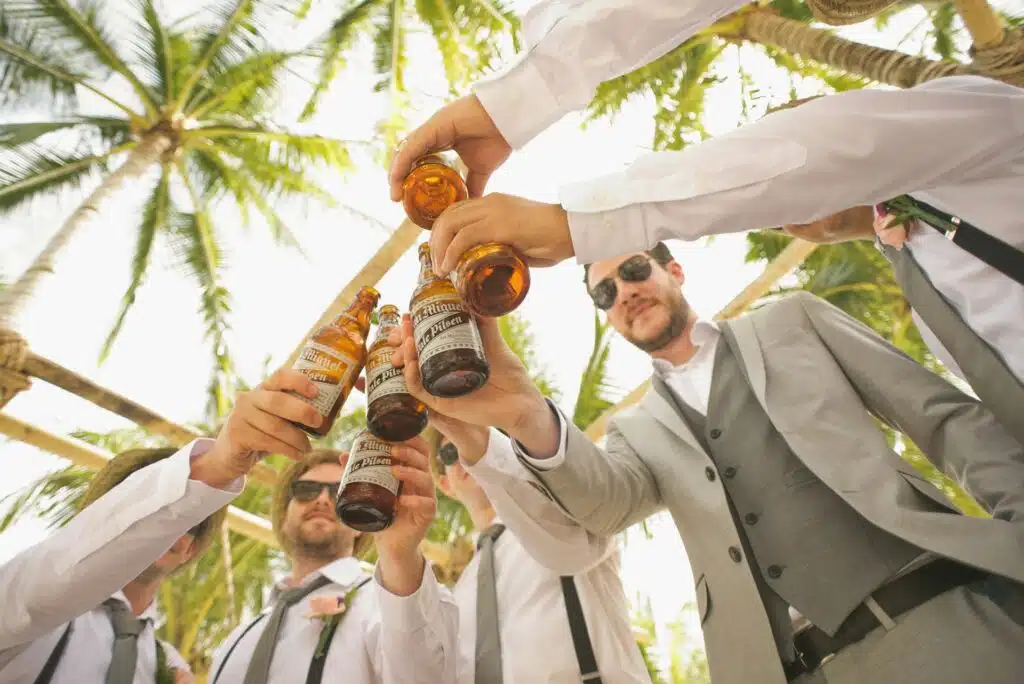
Wedding Attire by Venue and Theme
When dressing for a wedding, the venue and theme significantly influence attire choices. A beach ceremony calls for light fabrics and colors, while a traditional church wedding favors classic suits. Always align your outfit with the wedding’s setting to look your best and honor the couple’s vision.
Beach and Cruise Ship Wedding Attire for Men
For beach and cruise ship weddings, men should aim for a balance between comfort and respecting the occasion. A linen suit or a light-colored blazer paired with a collared shirt keeps it appropriately semi-formal.
Opt for navy suits or bright colors to complement the setting. Avoid tuxedo shirts and heavy fabrics; instead, go for a breathable linen suit or a collared dress shirt. Accessories like pocket squares can add a finishing touch, but remember to wear casual shoes and keep casual accessories understated.
The bride and groom may specify if guests can wear jeans or if afternoon weddings require more semi-formal attire.
Garden and Outdoor Wedding Styles
Outdoor weddings typically blend elegance with a touch of informality. A well-tailored suit in a breathable fabric ensures comfort without sacrificing style. Earth tones or soft pastels can harmonize with the natural setting.
Choose accessories that reflect the garden’s colors, and consider lighter footwear that can handle walking on the grass while still looking sharp.
Sophistication at City and Ballroom Weddings
City and ballroom weddings call for a level of sophistication in men’s attire. A sharp, tailored suit or tuxedo is essential, with attention to detail in accessories like cufflinks, ties, and pocket squares. Keep colors classic and materials luxurious to match the grandeur of the setting, ensuring you look as dapper as the metropolitan backdrop.
Rustic, Nautical, and Vintage Wedding Attire Ideas
Rustic, nautical, and vintage themes offer creative wedding dressing opportunities. Embrace tweed or herringbone for a rustic affair, while nautical events can play with navy blazers and crisp white trousers.
Vintage-inspired attire might include waistcoats, suspenders, and period-appropriate ties, allowing men to explore different eras while keeping the look cohesive and themed.
Wedding Attire for Every Role
Every role in a wedding, from the groom to the guests, has its attire considerations. The groom should look distinguished, while groomsmen aim for uniformity with a personal twist.
The couple’s fathers exude classic elegance, and guests balance respect for the event with their style. Each should dress appropriately to celebrate the occasion with grace and poise.
Groom’s Guide to Dressing for the Big Day
The groom’s attire is central to the wedding’s aesthetic. His suit or tuxedo should fit flawlessly and reflect the event’s formality. Whether opting for timeless black or a more contemporary color, the groom must stand out while complementing the bride’s attire.
Special Considerations for the Groom’s Attire
Special considerations for the groom include selecting a suit that sets him apart from the groomsmen, perhaps through a unique boutonniere or a distinct tie pattern. The fit must be impeccable, requiring professional tailoring.
Thoughtful details like a personalized pocket square or heirloom cufflinks can add sentimental value to the groom’s ensemble, making his attire as memorable as the day.
Best Man and Groomsmen: Uniformity with Individual Flair
For the best man and groomsmen, selecting a wedding outfit for men that achieves uniformity and personal flair is essential. While the attire should complement the groom’s look, small details like a unique tie pattern or a distinctive lapel pin allow individuality. This harmonious blend ensures the wedding party appears cohesive in photos while celebrating each person’s style.
Father of the Bride and Groom: Timeless Elegance
The fathers of the bride and groom should aim for timeless elegance, with classic suit or tuxedo options that reflect the event’s formality. A well-tailored suit in a neutral color, paired with a tasteful tie and pocket square, can seamlessly align with the wedding’s sophistication while showcasing its distinguished role in the celebration.
Wedding Guests: Balancing Respect and Self-Expression
Wedding guests can honor formal dress codes or cocktail dress expectations while expressing personal style. Whether it’s a bold tie or a uniquely patterned dress shirt, guests should find ways to stand out respectfully.
It’s about striking a balance – adhering to the dress code while allowing personal taste to shine through in the details.
Practical Tips for Wedding Attire Shopping
When shopping for men’s wedding guest attire, it’s crucial to consider wedding dress codes and themes. A casual wedding dress like a linen suit may be appropriate for casual weddings. Start early to ensure a perfect fit and availability, keeping in mind the seasonal styles and the wedding party’s overall look to ensure cohesion.
Where to Shop for Quality Men’s Wedding Outfits
For impeccable black-tie attire or a touch of elegance in semi-formal wear, men should visit reputable tailors and specialty menswear stores. These establishments offer quality garments and expert advice to create a polished wedding ensemble that reflects the occasion’s grandeur and the wearer’s style.
The Timing of Purchases: Avoiding Last-Minute Stress
Timing is critical when purchasing wedding attire. Begin several months in advance to allow for tailoring and adjustments. Early selection prevents the stress of last-minute shopping, ensuring that the outfit reflects both the event’s elegance and the wearer’s comfort.
Budgeting for Your Wedding Wardrobe
Set a clear budget for your wedding wardrobe to manage expenses effectively. Consider the cost of the suit, accessories, and potential alterations. Prioritize essential items and remember that investing in quality pieces can offer a better fit and longer-lasting style.
Etiquette and Mistakes to Avoid
One of the key mistakes to avoid is dressing overly casual for a wedding. Even at less formal events, it’s important to respect the occasion and opt for attire that is a step above everyday wear, ensuring that your look is appropriate and respectful of the event’s significance.
Overdressing vs Underdressing: Finding the Middle Ground
Finding the middle ground between overdressing and underdressing can be challenging. Consider the venue, time of day, and season. Aim for a polished look that aligns with the event’s formality without overshadowing the wedding party or appearing underdressed.
Adhering to the Couple’s Wishes and Dress Code
Respect the couple’s wishes and the stated dress code. Whether it specifies black-tie attire or a more relaxed vibe, your outfit should reflect their vision for the day. Ignoring these guidelines can be seen as a sign of disrespect and may result in standing out for the wrong reasons.
Common Faux Pas in Men’s Wedding Attire
Avoid common faux pas such as wearing black-tie attire to a semi-formal event or sporting loud, flashy accessories that distract from the wedding’s theme.
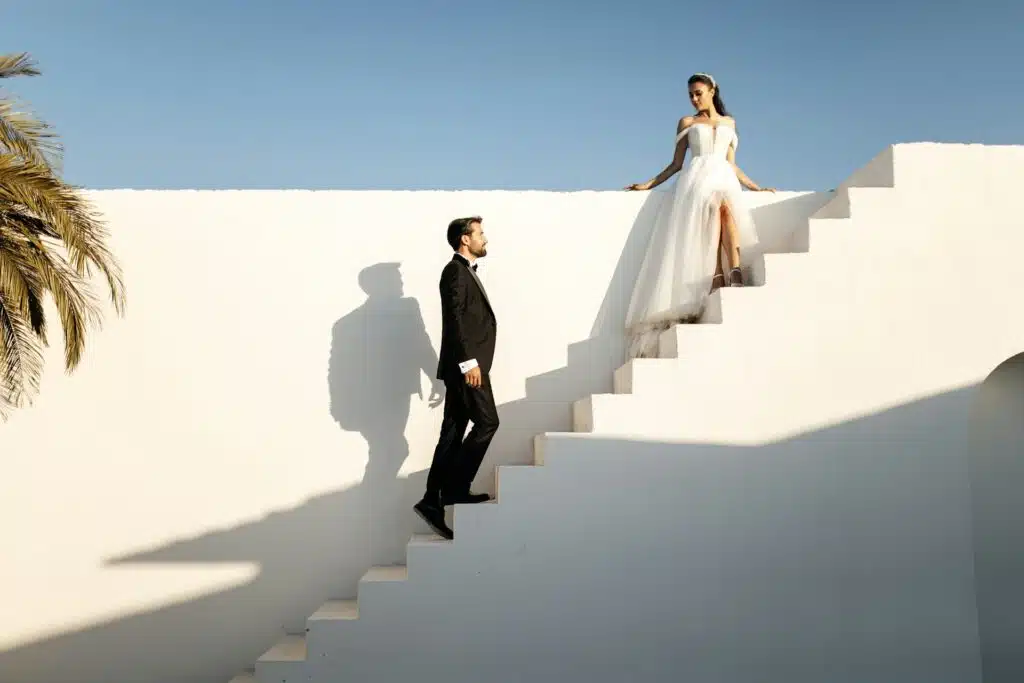
Keeping Comfort and Personal Style in Mind
While adhering to the dress code, men should not sacrifice comfort or personal style. The key is choosing garments that fit well and reflect one’s personality while being suitable for the event. This approach ensures confidence and poise, which are as crucial as the attire itself.
Balancing Comfort with Formality
Comfort and formality can go hand in hand with carefully selecting fabrics and fit. Opt for breathable materials and a cut that allows movement, ensuring you enjoy the celebration without feeling restricted by your outfit.
Wedding Attire by Dress Code
Men should opt for a well-fitted suit or tuxedo for black-tie events, while suits can be appropriate for semi-formal dress codes. A suit or blazer in forest green can offer a unique touch for fall weddings without compromising formality.
When the dancing begins, ensure your ensemble remains sharp with a secure tie bar and sophisticated jewelry that complements, rather than overshadows, the formal wear.
Visual Examples of Attire for Each Dress Code
Visual examples are invaluable when it comes to interpreting wedding dress codes. These examples, often provided by style guides, men’s fashion magazines like GQ or Esquire, or even online retailers like Nordstrom and Mr. Porter, can offer a clear picture of the level of formality expected.
Sometimes, couples themselves may include a style board or Pinterest link on the wedding website, especially for themed weddings, giving guests a helpful point of reference. Social media platforms such as Instagram and Pinterest are also rich sources for outfit inspiration, often shared by style influencers or wedding planners.
When in doubt, seeking out visual examples can provide clarity, helping you avoid any outfit missteps and ensuring you arrive dressed to match the occasion’s vibe.
Tailoring Your Look to the Time of Day
Time of day plays a crucial role in selecting appropriate wedding attire. Morning and afternoon events typically call for lighter colors and more relaxed styles, while evening occasions demand darker suits and more luxurious fabrics. Assess the wedding’s timing to ensure your outfit aligns with the expected formality and ambiance of the event.
Daytime vs. Evening Wedding Attire Differences
Daytime weddings allow for more playful attire; think lighter fabrics and colors. When wearing a tuxedo isn’t necessary, a light grey suit can be perfect. Evening weddings, however, often call for a more formal approach.
Darker hues and sharper tailoring are preferred, aligning with the sophistication of nighttime celebrations and the traditional expectation of elevated evening wear.
Adjusting Accessories and Colors Based on Time of Day
Accessories and color choices should harmonize with the time of the event. For daytime affairs, embrace lighter colors that complement the natural light and your skin tone. As the sun sets, transition to deeper shades and more formal accessories like cufflinks and a sleek dress watch, which add a touch of evening elegance to your attire.
Ensuring a Lasting Impression with Your Wedding Attire
When aiming to dress to impress, consider the location of the wedding. Always opt to be slightly overdressed than underdressed, as removing a tie or unbuttoning a shirt is easier than elevating an overly casual look.
Invest in a formal suit made from lightweight wool for those attending a formal wedding, ensuring comfort and style. Conversely, casual wedding attire for men may include mix-and-match pieces like chinos with a collared shirt, allowing for bold colors and relaxed styles.
Wedding guests should remember that regardless of the dress code, selecting pieces that fit well and reflect the wedding’s tone will ensure you make a lasting impression.
The Importance of Confidence and Comfort in Your Outfit
For beach weddings or similarly relaxed venues, comfort is key. A breathable collar shirt paired with lightweight trousers ensures ease throughout the event. Confidence in your attire comes from knowing it’s appropriate for the occasion and fits well.
It’s about feeling good in what you wear, whether a casual ensemble or a more formal tuxedo, and letting that assurance shine through.
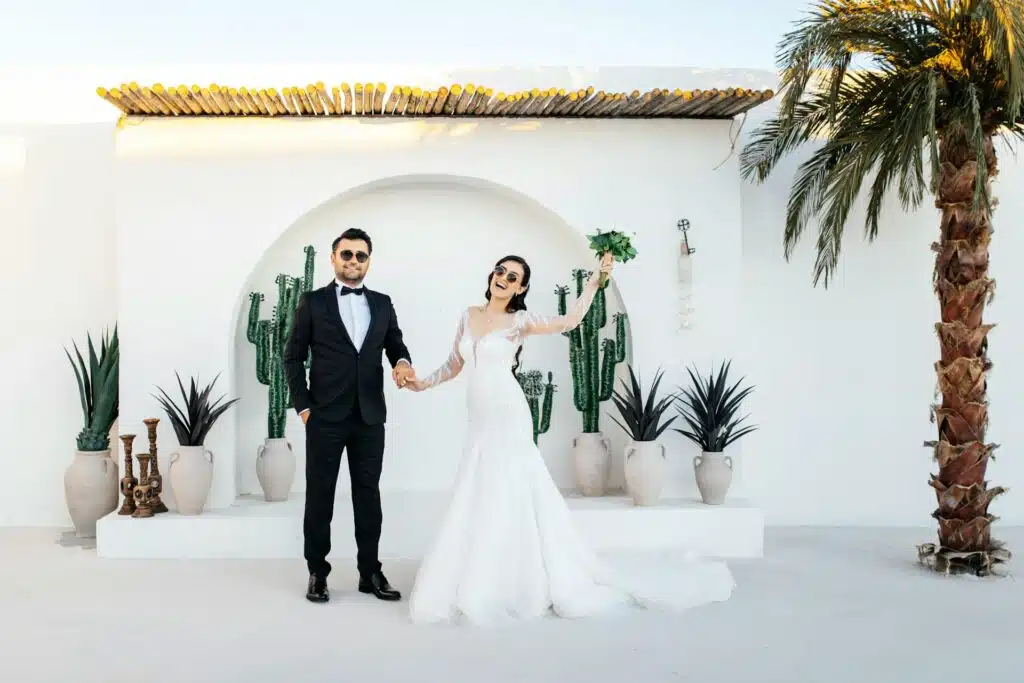
Final Thoughts on Nailing the Perfect Wedding Ensemble for Men
Deciding what to wear to a wedding involves balancing tradition with personal style. Opt for lightweight suits and tuxedos for beach weddings that reflect the setting’s informality.
Spring and summer celebrations invite you to wear a bow tie and inject personality through patterns and colors. Conversely, black-tie weddings require a more conservative approach, favoring classic styles and understated elegance.
Remember, expressing your personal style doesn’t mean disregarding the event’s formality. It’s about finding subtle ways to showcase your individuality, whether it’s through a unique pocket square or a tasteful lapel pin. The goal is to look cohesive with the wedding’s aesthetic while standing out for the right reasons.
